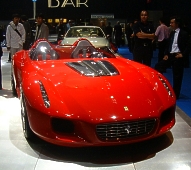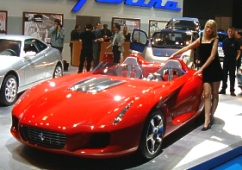
.
. .
.. . . .
. .
Other Pininfarina Other Engineering Companies & Coachbuilder
© 1998 - 2005
Copyright & |
. Pininfarina: The Rossa Concept
The mechanicals are from the 550 Maranello with the same wheelbase and tracks. The formal interpretation, by contrast, is absolutely free-wheeling in the best tradition of pure research by Pininfarina whose concept cars based on Ferrari mechanicals have included such recognised masterpieces as the Dino Berlinetta Speciale, the P5, the 512S, the Modulo and the Pinin, to name but five.
Photos: Pininfarina In its balanced deployment of solid masses and empty spaces, the tail of the Rossa reiterates the key themes of the nose. Hence the mouth of the grille on the front becomes the low relief of the number plate housing and the two air intakes are transformed into the apertures for the tail's twin exhaust pipes.
Photos: Automotive Intelligence The lighting clusters, on the other hand, mark a distinct change of direction: at the front a slash over the crest of the wing, at the rear a double cavity that evokes the high set exhausts of Ferrari's current Formula 1 cars. The two clearly outlined roll bars are linked by a transverse fin that serves a dual purpose since it houses both the leds of the third stop light and a pair of cameras. The function of the camera facing the rear is self-evident: it replaces the rear-view mirror by delivering picture signals to the LCD screen on the central console. The second camera on the other hand, is focused on the driver and is connected to the on-board video-recording system. In this way it provides the driver with his own in-built camera car and enables him to create a video library he can access for memories of open car driving and its joys on those dark, wintry days when he has to leave his two-seater spider in the garage. The Sides It has taken Pininfarina just a few decisive pencil strokes to endow the Rossa with a profoundly meaningful sideview. The crest of the wing tapers as it approaches the cabin to create the base line for the slender swoop of glazing along the side. The result is a flowing solid section to set against the vacuum left by the front wing which is so deeply recessed that it merely forms a lid for the engine bay. This subtle balance between plenitude and vacuum is interrupted by the fin that rises from the sill to frame the front wheel: a contemporary interpretation of a key design feature from the 1958 Testa Rossa. That fin is a decorative element which also houses a functional component in the form of the direction indicator flasher. In side view the Rossa revives a surface treatment last seen on the Mythos but is here extended along the entire body of the car which seems to be wedged into a much wider bonnet. The modeling of the sides is a subtle interplay of softly moulded surfaces bordered by sharp angles which might be described as a biodesign reinforced by visible ribbing. The slender flow of the glazing completes the overall design without disturbing it, the only interruption being provided by the two roll-bars that crouch over a tail-end that slopes gently downwards. The Front The nose of the Rossa incorporates a classic Ferrari radiator grille, its blunted trapezoid shape embellished by the prancing horse motif at the centre and a rectangular grid with big air intakes serving the brakes and engine bay at each end. In other words, however totally different in form and function, the three key elements that have featured on all recent Ferraris. On this particular car, the planes into which these apertures are carved are forcefully characterised: the centre of the nose protrudes to transform the radiator grille into a shark-like mouth, while the air intakes are pushed back into the natural perimeter of the car. However, since an over-long bonnet would have ruptured the overall tension, the Rossa turns its back on that possibility and the designers leave the top of the engine visible to the naked eye. Forty years ago, it was the carburettor intake stacks that protruded out of the sheet steel. This time it is the ducts whose smoothly uninterrupted shapes form a more harmonious partnership with the lines of the bodywork. However, setting the engine in relief serves more than a purely decorative purpose, since it has allowed to lower the bonnet line far more than would otherwise have been possible and that in its turn retrieves the magical equilibrium characteristic of the classic sports car on which the wings rise to embrace the bonnet. That too is a Pininfarina - Ferrari classic, traditionally seen on rear-engined models but here making an appearance on a front-engined car. Finally, the windscreen is reduced to a sliver of glass that merely displaces the air when the car is driven at speed and offers no protection whatsoever from the rain. This is after all an open sports car and like any self-respecting spider thoroughbred rejects the mere thought of even the skimpiest canvas roof with a shudder of well-bred disdain. The interiors The cockpit of the Rossa is as dynamic as the bodywork, no more than a driver-sized niche carved out of the car's flowing lines. It's hard in fact to say when interior becomes interior: bent by the windscreen the bonnet changes direction to become the facia without changing pace, as the paintwork of the body panels surge along the central tunnel and up the seat backs which themselves metamorphose into a boot-lid.
Most of the door panel is also painted body colour; only the passenger-side door gets a bit of padding covered in the same grey leather as the tub-shaped seats with their four-point seat-belts. To take another example, the shift gate is not embedded in the central console but emerges from it to create a colour contrast with the red that dominates the Rossa, inside as well as out. October 2000
Photos: Pininfarina . |









